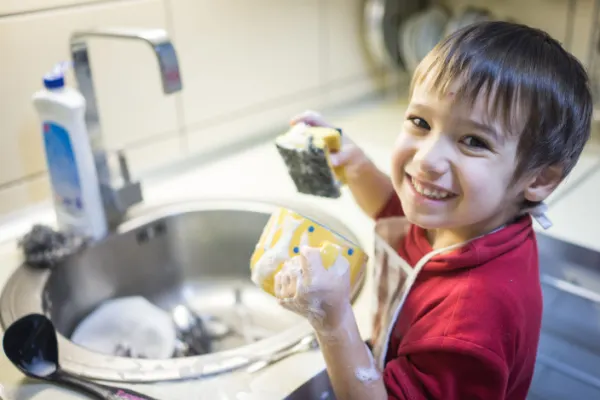
Molly Maid recommends involving children in dinnertime chores to teach responsibility and teamwork.
|
The back-to-school season challenges even the most organized families. Everyone—even the pets—must get into a new routine and keep up with its many demands. Packing lunches, rides to and from school and other activities, and homework all must get done. Many parents ask their kids to pitch in around the house to ease the transition and beyond. Here’s how you can do the same around dinnertime in particular.

The Benefits of Assigning Chores
Let’s face it: Properly done chores help make your life easier. Children may not get a particular job right the first time, but practice makes perfect. They will feel a sense of pride in having mastered a task and will learn responsibility, a character trait needed in order to grow into a contributing member of society. You can also tie chores to rewards, which again teaches the important lesson of working for what you want. Small prizes are a treat for younger kids, with an accumulation of “points” working well for older kids who may want a larger reward such as a new video game or a special outing.
Picking Age-Appropriate Tasks
Not all dinnertime and after chores work for all ages. Obviously, your 3-year-old should not carry breakable dishes to the sink or roll the garbage bin down to the curb the night before pickup. You know your kid’s capabilities best, but our suggested chores-by-age chart can serve as a guideline.
It recommends having children ages 2 to 3 wipe up spills, and then graduate to helping clear the table by age 5. Those ages 6 to 7 can help make their lunch, with loading the dishwasher an appropriate chore by ages 8 and 9. By age 10, you may want to assign them after-dinner clean-up duty a few times a week.
Other dinnertime to-do’s for various ages can include setting the table, helping cook dinner, feeding the family pets, unloading the dishwasher, doing hand-washing, wiping the table and counters clean, and taking out the trash.
Making Chores Fun
By definition, chores are “a small job that is done regularly” or “a dull, unpleasant, or difficult job or experience.” Try to instill in your kids the former view and not the latter by making them as fun as possible.
In addition to the chore-by-ages chart, we have charts you can use to assign and check off tasks as they get done. You can also use stickers to note when jobs are completed. These colorful chore charts come pre-filled with suggested to-do’s or blank, so you can customize them for your kids.
One mother on Pinterest also showed how she uses chore sticks to mix things up around the house. She writes various tasks on popsicle sticks and lets the kids close their eyes and choose. It keeps them learning new tasks and alleviates boredom with the same ones over and over again each day. For help with dinnertime and after chores, have them choose when they get home from school so they know what to expect and can get started early if they want.
Other ways you can make chores fun include:
- Playing upbeat music in the kitchen, with children alternating as DJs.
- Turning certain chores into a game, such as passing the dishes to the kitchen or from the dishwasher to their storage spots.
- Dancing while you do chores, just be careful with dishes!
All of the above will help ease the load of parents and contribute to a sense of family. Chores should never be used as a punishment for kids, but instead a way for them to contribute to the shared responsibilities of parents, siblings and other relatives.
For your home cleaning needs, contact the professionals at Molly Maid. Each maid services team comprises insured, licensed and uniformed housekeepers who are regularly supervised. Click here to request service in your area.
